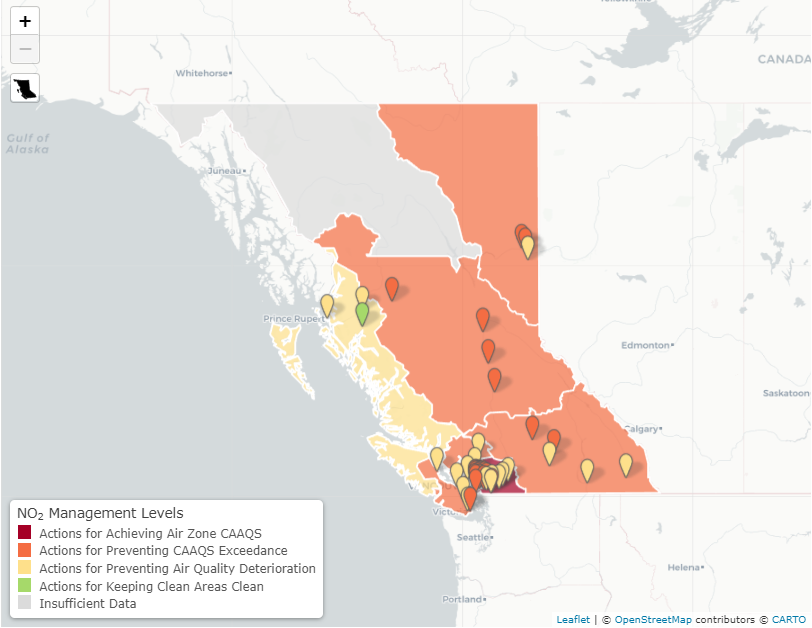Status of Nitrogen Dioxide in B.C. (2020-2022)
British Columbia operates a network of air monitoring stations that measure nitrogen dioxide and other air pollutants. This indicator reports on the concentration of nitrogen dioxide and compares it to the Canadian Ambient Air Quality Standards established by the Canadian Council of Ministers of the Environment.
- Nitrogen Dioxide (NO2) is a gaseous pollutant. It is formed along with other nitrogen oxides (NOx) during the combustion of fossil fuels in cars, trucks, ships, and industrial facilities.
- NO2 exposure is known to affect human health and the environment. Long term exposures, for example, has been shown to induce the development of allergic responses, asthma, increases the susceptibility for respiratory infections (including COVID-19), and has been linked to cardiovascular system and reproductive effects. Short term exposures can reduce lung function and aggravate respiratory symptoms and airway inflammation. These effects have no observed lower threshold, i.e., negative effects are observed even at low concentrations.
- Environmental effects of NO2 (and NOx in general) include altered plant growth due to absorption through their leaves and from nitrogen deposition. Impact on plants can negatively affect animals like caribou that depend on arboreal lichens for sustenance. NO2 also has indirect effects including its role in ozone formation and acid rain. Ozone is detrimental to plant life because exposure oxidizes (burns) plant tissues, and acid rain results in the acidification and eutrophication of ecosystems. Reddish-brown haze commonly found over urban centres is the result of higher concentrations of NO2 pollution.
The map below summarises the assigned management levels for nitrogen dioxide in B.C.'s air zones, as well as the levels of the pollutant at individual monitoring stations. The color of each region refers to the management level. The four management levels are: (1) green (actions for keeping clean areas clean); (2) yellow (actions for preventing air quality deterioration); (3) orange (actions for preventing Canadian Ambient Air Quality Standard exceedance); and (4) red (actions for achieving air zone Canadian Ambient Air Quality Standard). Each management level is associated with a suite of actions that become more rigorous as nitrogen dioxide levels approach the standard. More information on Management Levels can be found below. The map shows air quality stations with sufficient data to report for the 2020-2022 reporting period.
Tip: Click or tap on an air zone or monitoring station to see details on the status of nitrogen dioxide levels for the 2020-2022 reporting period.
Tip: See Table 6.1 in the Guidance Document on Air Zone Management (CCME, 2019) for more information about the suggested actions for each color/management level in the map below.
Nitrogen Dioxide (NO2): Canadian Ambient Air Quality Standard
NO2 levels are calculated using two statistical forms called the annual and the 1-hour metrics. The Canadian Ambient Air Quality Standards for NO2 are achieved when annual metrics are 17 parts per billion (ppb) or lower and the 1-hour metrics are 60 ppb or lower.
- Nitrogen dioxide levels met both of the Canadian Ambient Air Quality Standards at 100% of the assessed monitoring stations in B.C. There are two standards for NO2—an annual standard and a 1-hour standard (see sidebar). The annual and 1-hour standards were met at 45 of the 45 stations (100%) with sufficient data for analysis.
- Nitrogen dioxide levels met both of the Canadian Ambient Air Quality Standards in all of B.C.’s air zones that are monitored. Currently, there are no air monitoring stations in the Northwest air zone.
What is an Air Zone?
British Columbia is divided into seven air zones. These are areas with similar air quality characteristics, issues, and/or trends.


 Your screen is too small to display the interactive map. Click to see the interactive
visualization in full-screen.
Your screen is too small to display the interactive map. Click to see the interactive
visualization in full-screen.
